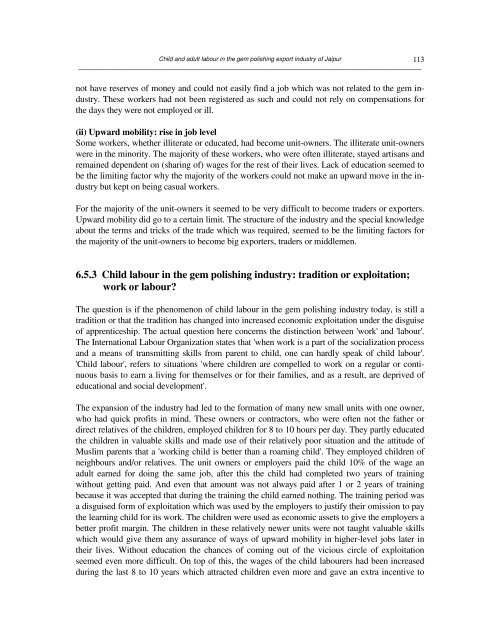You also want an ePaper? Increase the reach of your titles
YUMPU automatically turns print PDFs into web optimized ePapers that Google loves.
<strong>Child</strong> <strong>and</strong> <strong>adult</strong> <strong>labour</strong> <strong>in</strong> <strong>the</strong> <strong>gem</strong> polish<strong>in</strong>g <strong>export</strong> <strong>in</strong>dustry <strong>of</strong> Jaipur<br />
──────────────────────────────────────────────────────────────────────────────────────────────<br />
not have reserves <strong>of</strong> money <strong>and</strong> could not easily f<strong>in</strong>d a job which was not related to <strong>the</strong> <strong>gem</strong> <strong>in</strong>dustry.<br />
These workers had not been registered as such <strong>and</strong> could not rely on compensations for<br />
<strong>the</strong> days <strong>the</strong>y were not employed or ill.<br />
(ii) Upward mobility: rise <strong>in</strong> job level<br />
Some workers, whe<strong>the</strong>r illiterate or educated, had become unit-owners. The illiterate unit-owners<br />
were <strong>in</strong> <strong>the</strong> m<strong>in</strong>ority. The majority <strong>of</strong> <strong>the</strong>se workers, who were <strong>of</strong>ten illiterate, stayed artisans <strong>and</strong><br />
rema<strong>in</strong>ed dependent on (shar<strong>in</strong>g <strong>of</strong>) wages for <strong>the</strong> rest <strong>of</strong> <strong>the</strong>ir lives. Lack <strong>of</strong> education seemed to<br />
be <strong>the</strong> limit<strong>in</strong>g factor why <strong>the</strong> majority <strong>of</strong> <strong>the</strong> workers could not make an upward move <strong>in</strong> <strong>the</strong> <strong>in</strong>dustry<br />
but kept on be<strong>in</strong>g casual workers.<br />
For <strong>the</strong> majority <strong>of</strong> <strong>the</strong> unit-owners it seemed to be very difficult to become traders or <strong>export</strong>ers.<br />
Upward mobility did go to a certa<strong>in</strong> limit. The structure <strong>of</strong> <strong>the</strong> <strong>in</strong>dustry <strong>and</strong> <strong>the</strong> special knowledge<br />
about <strong>the</strong> terms <strong>and</strong> tricks <strong>of</strong> <strong>the</strong> trade which was required, seemed to be <strong>the</strong> limit<strong>in</strong>g factors for<br />
<strong>the</strong> majority <strong>of</strong> <strong>the</strong> unit-owners to become big <strong>export</strong>ers, traders or middlemen.<br />
113<br />
6.5.3 <strong>Child</strong> <strong>labour</strong> <strong>in</strong> <strong>the</strong> <strong>gem</strong> polish<strong>in</strong>g <strong>in</strong>dustry: tradition or exploitation;<br />
work or <strong>labour</strong>?<br />
The question is if <strong>the</strong> phenomenon <strong>of</strong> child <strong>labour</strong> <strong>in</strong> <strong>the</strong> <strong>gem</strong> polish<strong>in</strong>g <strong>in</strong>dustry today, is still a<br />
tradition or that <strong>the</strong> tradition has changed <strong>in</strong>to <strong>in</strong>creased economic exploitation under <strong>the</strong> disguise<br />
<strong>of</strong> apprenticeship. The actual question here concerns <strong>the</strong> dist<strong>in</strong>ction between 'work' <strong>and</strong> '<strong>labour</strong>'.<br />
The International Labour Organization states that 'when work is a part <strong>of</strong> <strong>the</strong> socialization process<br />
<strong>and</strong> a means <strong>of</strong> transmitt<strong>in</strong>g skills from parent to child, one can hardly speak <strong>of</strong> child <strong>labour</strong>'.<br />
'<strong>Child</strong> <strong>labour</strong>', refers to situations 'where children are compelled to work on a regular or cont<strong>in</strong>uous<br />
basis to earn a liv<strong>in</strong>g for <strong>the</strong>mselves or for <strong>the</strong>ir families, <strong>and</strong> as a result, are deprived <strong>of</strong><br />
educational <strong>and</strong> social development'.<br />
The expansion <strong>of</strong> <strong>the</strong> <strong>in</strong>dustry had led to <strong>the</strong> formation <strong>of</strong> many new small units with one owner,<br />
who had quick pr<strong>of</strong>its <strong>in</strong> m<strong>in</strong>d. These owners or contractors, who were <strong>of</strong>ten not <strong>the</strong> fa<strong>the</strong>r or<br />
direct relatives <strong>of</strong> <strong>the</strong> children, employed children for 8 to 10 hours per day. They partly educated<br />
<strong>the</strong> children <strong>in</strong> valuable skills <strong>and</strong> made use <strong>of</strong> <strong>the</strong>ir relatively poor situation <strong>and</strong> <strong>the</strong> attitude <strong>of</strong><br />
Muslim parents that a 'work<strong>in</strong>g child is better than a roam<strong>in</strong>g child'. They employed children <strong>of</strong><br />
neighbours <strong>and</strong>/or relatives. The unit owners or employers paid <strong>the</strong> child 10% <strong>of</strong> <strong>the</strong> wage an<br />
<strong>adult</strong> earned for do<strong>in</strong>g <strong>the</strong> same job, after this <strong>the</strong> child had completed two years <strong>of</strong> tra<strong>in</strong><strong>in</strong>g<br />
without gett<strong>in</strong>g paid. And even that amount was not always paid after 1 or 2 years <strong>of</strong> tra<strong>in</strong><strong>in</strong>g<br />
because it was accepted that dur<strong>in</strong>g <strong>the</strong> tra<strong>in</strong><strong>in</strong>g <strong>the</strong> child earned noth<strong>in</strong>g. The tra<strong>in</strong><strong>in</strong>g period was<br />
a disguised form <strong>of</strong> exploitation which was used by <strong>the</strong> employers to justify <strong>the</strong>ir omission to pay<br />
<strong>the</strong> learn<strong>in</strong>g child for its work. The children were used as economic assets to give <strong>the</strong> employers a<br />
better pr<strong>of</strong>it marg<strong>in</strong>. The children <strong>in</strong> <strong>the</strong>se relatively newer units were not taught valuable skills<br />
which would give <strong>the</strong>m any assurance <strong>of</strong> ways <strong>of</strong> upward mobility <strong>in</strong> higher-level jobs later <strong>in</strong><br />
<strong>the</strong>ir lives. Without education <strong>the</strong> chances <strong>of</strong> com<strong>in</strong>g out <strong>of</strong> <strong>the</strong> vicious circle <strong>of</strong> exploitation<br />
seemed even more difficult. On top <strong>of</strong> this, <strong>the</strong> wages <strong>of</strong> <strong>the</strong> child <strong>labour</strong>ers had been <strong>in</strong>creased<br />
dur<strong>in</strong>g <strong>the</strong> last 8 to 10 years which attracted children even more <strong>and</strong> gave an extra <strong>in</strong>centive to


















